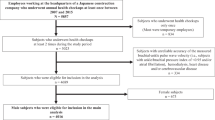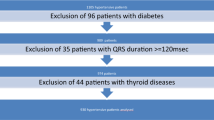Abstract
Research studies on hypertension have, so far, generally focused on vascular resistance and small arteries. The high prevalence of systolic hypertension in patients older than 50 years and the development of noninvasive Doppler and echotracking techniques have made it possible to determine large-artery stiffness with a high degree of reproducibility. Increased arterial stiffness and disturbed wave reflections are the basis for understanding reduced aortic elasticity and systolic hypertension, particularly in older people. This hemodynamic pattern results from mechanical factors and other pressure-independent risk factors, such as diabetes mellitus, renal failure, obesity and severe atherosclerosis. Distinct phenotypes of arterial stiffness and pulse pressure result from specific gene polymorphisms, such as those related to the renin–angiotensin system. The roles of arterial stiffness and wave reflections in hypertension have been elucidated by modern interpretations of the blood-pressure curve in relation to its propagation, mechanisms of systolic-blood-pressure amplification, and the pulse-pressure amplitude. New predictors of cardiovascular risk have been identified, such as increased pulse pressure and pulse-wave velocity, and disturbed wave reflections, all of which are independent predictors of cardiovascular risk that are more powerful than either systolic or diastolic blood pressure alone. Therapeutic trials are investigating ways to reduce stiffness, and thereby allow the selective reduction of systolic and pulse pressure in hypertensive patients with or without advanced renal failure. Modern pharmacologic agents need to be identified, which could reduce systolic hypertension in patients older than 50 years. Here we discuss the structural and functional factors that influence arterial stiffness, wave reflections and pulse pressure in hypertension, as well as their related roles in cardiovascular risk.
This is a preview of subscription content, access via your institution
Access options
Subscribe to this journal
Receive 12 print issues and online access
$209.00 per year
only $17.42 per issue
Buy this article
- Purchase on Springer Link
- Instant access to full article PDF
Prices may be subject to local taxes which are calculated during checkout


Similar content being viewed by others
References
Safar ME et al. (2003) Current perspectives on arterial stiffness and pulse pressure in hypertension and cardiovascular diseases. Circulation 107: 2864–2869
Franklin SS et al. (1997) Hemodynamic patterns of age-related changes in blood pressure. The Framingham Heart Study. Circulation 96: 308–315
Safar ME (2001) Systolic blood pressure, pulse pressure and arterial stiffness as cardiovascular risk factors. Curr Opin Nephrol Hypertens 10: 257–261
Black HR (1999) The paradigm has shifted to systolic blood pressure. Hypertension 34: 386–387
Safar ME et al. (2000) Stiffness of carotid artery wall material and blood pressure in humans. Stroke 31: 782–790
Balkenstein EJ et al. (2001) Carotid and femoral artery stiffness in relation to three candidate genes in a white population. Hypertension 38: 1190–1197
Safar ME (2004) Angiotensin-converting enzyme D/I gene polymorphism and age-related changes in pulse pressure in subjects with hypertension. Arterioscler Thromb Vasc Biol 24: 782–786
Alderman MH et al. (1998) Distribution and determinants of cardiovascular events during 20 years of successful antihypertensive treatment. J Hypertens 16: 761–769
Blacher J et al. (1999) Impact of aortic stiffness on survival in end-stage renal failure. Circulation 99: 2434–2439
Pannier B et al. (2005) Stiffness of capacitive and conduit arteries: prognostic significance for end-stage renal disease patients. Hypertension 45: 592–596
Blacher J et al. (2001) Arterial calcifications, arterial stiffness, and cardiovascular risk in end-stage renal disease. Hypertension 38: 938–942
Blacher J et al. (1998) Carotid arterial stiffness as a predictor of cardiovascular and all-cause mortality in end-stage renal disease. Hypertension 32: 570–574
London GM et al. (2001) Arterial wave reflections and survival in end-stage renal failure. Hypertension 38: 434–438
Shoji T et al. (2001) Diabetes mellitus, aortic stiffness, and cardiovascular mortality in end-stage renal disease. J Am Soc Nephrol 12: 2117–2124
Barenbrock M et al. (2002) Reduced arterial distensibility is a predictor of cardiovascular disease in patients after renal transplantation. J Hypertens 20: 79–84
Weber T et al. (2004) Arterial stiffness, wave reflections, and the risk of coronary artery disease. Circulation 109: 184–189
Blacher J et al. (1999) Aortic pulse wave velocity as a marker of cardiovascular risk in hypertensive patients. Hypertension 33: 1111–1117
Anderson KM et al. (1991) Cardiovascular disease risk profiles. Am Heart J 121: 293–298
Meaume S et al. (2001) Aortic pulse wave velocity predicts cardiovascular mortality in subjects >70 years of age. Arterioscler Thromb Vasc Biol 21: 2046–2050
Laurent S et al. (2001) Aortic stiffness is an independent predictor of all-cause mortality in hypertensive patients. Hypertension 37: 1236–1241
Creager MA et al. (2003) Diabetes and vascular disease: pathophysiology, clinical consequences, and medical therapy: Part I. Circulation 108: 1527–1532
Lakatta EG (2003) Arterial and cardiac aging: major shareholders in cardiovascular disease enterprises. Part III: cellular and molecular clues to heart and arterial aging. Circulation 107: 490–497
Schram MT et al. (2004) Increased central artery stiffness in impaired glucose metabolism and type 2 diabetes: the Hoorn Study. Hypertension 43: 176–181
Schram MT et al. (2003) Pulse pressure is associated with age and cardiovascular disease in type 1 diabetes: the Eurodiab Prospective Complications Study. J Hypertens 21: 2035–2044
Cruickshank K et al. (2002) Aortic pulse-wave velocity and its relationship to mortality in diabetes and glucose intolerance: an integrated index of vascular function? Circulation 106: 2085–2090
Guerin AP et al. (2001) Impact of aortic stiffness attenuation on survival of patients in end-stage renal failure. Circulation 103: 987–992
London GM et al. (2004) Mechanism(s) of selective systolic blood pressure reduction after a low-dose combination of perindopril/indapamide in hypertensive subjects: comparison with atenolol. J Am Coll Cardiol 43: 92–99
Intengan HD et al. (1999) Resistance, artery mechanics, structure, and extracellular components in spontaneously hypertensive rats: effects of angiotensin receptor antagonism and converting enzyme inhibition. Circulation 100: 2267–2275
Ting CT et al. (1995) Short- and long-term effects of antihypertensive drugs on arterial reflections, compliance and impedance. Hypertension 26: 524–530
Rizzoni D et al. (2003) Prognostic significance of small-artery structure in hypertension. Circulation 108: 2230–2235
Van Bortel LM et al. (2001) Pulse pressure, arterial stiffness, and drug treatment of hypertension. Hypertension 38: 914–921
Author information
Authors and Affiliations
Corresponding author
Ethics declarations
Competing interests
The authors declare no competing financial interests.
Rights and permissions
About this article
Cite this article
Blacher, J., Safar, M. Large-artery stiffness, hypertension and cardiovascular risk in older patients. Nat Rev Cardiol 2, 450–455 (2005). https://doi.org/10.1038/ncpcardio0307
Received:
Accepted:
Issue Date:
DOI: https://doi.org/10.1038/ncpcardio0307
This article is cited by
-
Protective role of CXCR7 activation in neonatal hyperoxia-induced systemic vascular remodeling and cardiovascular dysfunction in juvenile rats
Scientific Reports (2023)
-
Association of waist-to-height ratio with hypertension and its subtypes in southern China
Journal of Human Hypertension (2022)
-
Altered Placental Chorionic Arterial Biomechanical Properties During Intrauterine Growth Restriction
Scientific Reports (2018)
-
TV-HLL Solver for One-Dimensional Fluid Flow Inside Elastic Vessels
International Journal of Applied and Computational Mathematics (2017)
-
Systemic arterial stiffness in infants with bronchopulmonary dysplasia: potential cause of systemic hypertension
Journal of Perinatology (2016)



